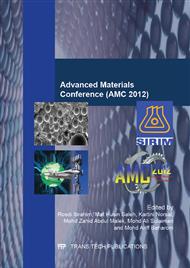[1]
S. Wang, P. Li, H. Liu, J. Li, Y. Wei. (2010). The structure and optical properties of ZnO nanocrystals dependence on Co-doping levels, J. Alloys Compd., 505, 362-366.
DOI: 10.1016/j.jallcom.2010.05.183
Google Scholar
[2]
R. Kumar, N. Khare. (2008). Temperature dependence of conduction mechanism of ZnO and Co-doped ZnO thin films, Thin Solid Films, 516, 1302–1307.
DOI: 10.1016/j.tsf.2007.06.121
Google Scholar
[3]
S. Kumar, R. Kumar, D.P. Singh. (2009). Swift heavy ion induced modifications in cobalt doped ZnO thin films: Structural and optical studies, Appl. Surf. Sci., 255, 8014-8018.
DOI: 10.1016/j.apsusc.2009.05.005
Google Scholar
[4]
E.V. Gritskova, D.M. Mukhamedshina, K.A. Mit', N.A. Dolya, K.A. Abdullin. (2009). The structure, photoluminescence, optical and magnetic properties of ZnO films doped with ferromagnetic impurities, Physica B, 404, 4816-4819.
DOI: 10.1016/j.physb.2009.08.307
Google Scholar
[5]
W. Zhuliang, L. Xiaoli, J. Fengxian, T. Baoqiang, L. Baohua, X. Xiaohong. (2008). The Effect of Substrate Temperature on the Room Temperature Ferromagnetism of Co-Doped ZnO Thin Films, Rare Met. Mater. Eng., 37.
DOI: 10.1016/s1875-5372(09)60021-7
Google Scholar
[6]
S.Y. Seo, C.H. Kwak, S.H. Kim, S.H. Park, I.J. Lee, S.W. Han. (2012). Synthesis and characterization of ferromagnetic Zn1−xCoxO films, J. Cryst. Growth, 346, 56-60.
DOI: 10.1016/j.jcrysgro.2012.02.022
Google Scholar
[7]
A. Wang, Z. Zhong, C. Lu, L. Lv, X. Wang, B. Zhang. (2011). Study on field-emission characteristics of electrodeposited Co-doped ZnO thin films, Physica B, 406, 1049-1052.
DOI: 10.1016/j.physb.2010.08.022
Google Scholar
[8]
J.J. Hassan, Z. Hassan, H. Abu-Hassan. (2011). High-quality vertically aligned ZnO nanorods synthesized by microwave-assisted CBD with ZnO–PVA complex seed layer on Si substrates, J. Alloys Compd., 509, 6711-6719.
DOI: 10.1016/j.jallcom.2011.03.153
Google Scholar
[9]
N. Ekem, S. Korkmaz, S. Pat, M.Z. Balbag, E.N. Cetin, M. Ozmumcu. (2009). Some physical properties of ZnO thin films prepared by RF sputtering technique, Int. J. Hydrogen Energy, 34, 5218-5222.
DOI: 10.1016/j.ijhydene.2009.02.001
Google Scholar
[10]
A.I. Ievtushenko, V.A. Karpyna, V.I. Lazorenko, G.V. Lashkarev, V.D. Khranovskyy, V.A. Baturin, O.Y. Karpenko, M.M. Lunika, K.A. Avramenko, V.V. Strelchuk, O.M. Kutsay. (2010). High quality ZnO films deposited by radio-frequency magnetron sputtering using layer by layer growth method, Thin Solid Films, 518, 4529-4532.
DOI: 10.1016/j.tsf.2009.12.023
Google Scholar
[11]
P. Li, S. Wang, J. Li, Y. Wei. (2012). Structural and optical properties of Co-doped ZnO nanocrystallites prepared by a one-step solution route, J. Lumin., 132, 220-225.
DOI: 10.1016/j.jlumin.2011.08.019
Google Scholar
[12]
H. Yang, S. Nie. (2009). Preparation and characterization of Co-doped ZnO nanomaterials, Materials Chemistry and Physics, 114, 279-282.
DOI: 10.1016/j.matchemphys.2008.09.017
Google Scholar
[13]
C. Xu, L. Cao, G. Su, W. Liu, X. Qu, Y. Yu. (2010). Preparation, characterization and photocatalytic activity of Co-doped ZnO powders, J. Alloys Compd., 497, 373-376.
DOI: 10.1016/j.jallcom.2010.03.076
Google Scholar
[14]
M. Ivill, S.J. Pearton, S. Rawal, L. Leu, P. Sadik, R. Das, A.F. Hebard, M. Chisholm, J.D. Budai, D.P. Norton. (2008). Structure and magnetism of cobalt-doped ZnO thin films, New J. Phys., 10, 065002.
DOI: 10.1088/1367-2630/10/6/065002
Google Scholar
[15]
W. Baiqi, S. Xudong, F. Qiang, J. Iqbal, L. Yan, F. Honggang, Y. Dapeng. (2009). Photoluminescence properties of Co-doped ZnO nanorods array fabricated by the solution method, Physica E, 41, 413-417.
DOI: 10.1016/j.physe.2008.09.001
Google Scholar


